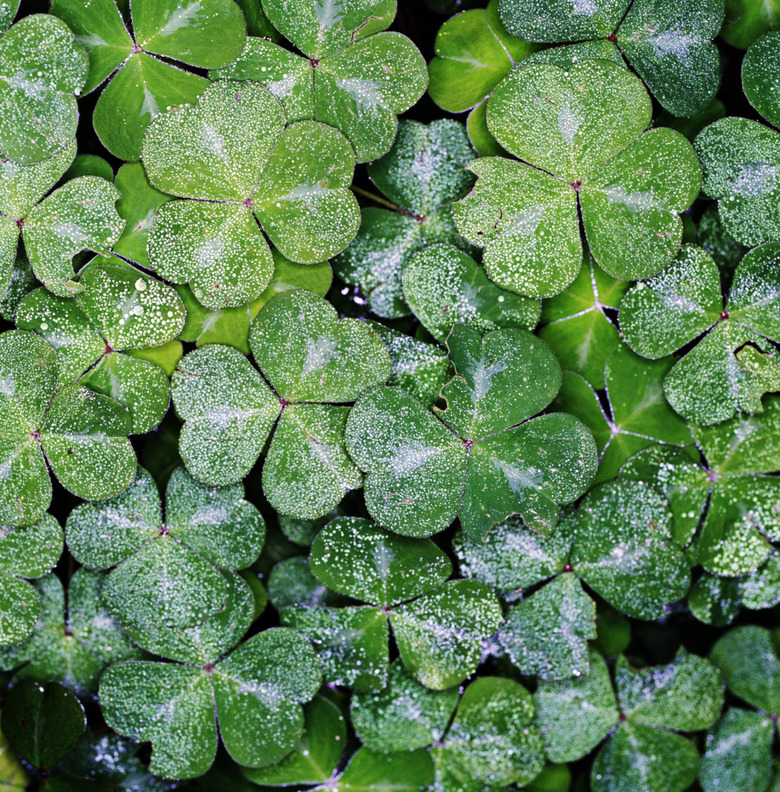Is Oxalis Poisonous To Dogs?
Oxalis species, more commonly referred to as shamrock plants, are usually associated with good luck. Shamrocks are popular houseplants and also grow outdoors in U.S. Department of Agriculture plant hardiness zones 6 through 11, depending on the species. Unfortunately, when it comes to dogs, these plants don't bring such good fortune because their three-leaved, shamrock-shaped foliage is poisonous to our canine companions if eaten.
Shamrocks
Step 1
Shamrock plants, also known as sorrels, good fortune plants or wood sorrels, have groupings of three heart-shaped leaves, which resemble leaves of the clover plant (Trifolium repens). Clover plants, which grow in USDA zones 3 through 10, are in a different family than shamrocks, which belong to the Oxalidaceae family. There are over 500 species of shamrock plants in the Oxalis genus, which are either annual or perennial herbs. Shamrocks grow best in full sun to partial shade and moist, well-drained soil, according to "Fine Gardening." The plants produce 5-petaled flowers that are bowl shaped and come in a variety of hues, including yellow, white, pink and violet.
- Oxalis species, more commonly referred to as shamrock plants, are usually associated with good luck.
- There are over 500 species of shamrock plants in the Oxalis genus, which are either annual or perennial herbs.
Toxicity
Step 1
Shamrocks are toxic to dogs and cats because they contain chemicals called soluble calcium oxylates in all parts of the plants, warns the American Society for the Prevention of Cruelty to Animals. Soluble calcium oxylates consist of oxalic acid and oxalate salts, both of which can poison your pet and lead to acute renal failure if ingested in large amounts, warns the Pet Poison Helpline. Calcium oxylate salts can also bind with calcium in a dog's body, causing a severe drop in the dog's calcium levels. Symptoms of shamrock poisoning in your dog include drooling, lack of appetite, lethargy, diarrhea, vomiting, tremors and bloody urine.
Treatment
Step 1
If you think that your dog has ingested any of your shamrock plants, take it to the veterinarian for treatment immediately. Poisoning symptoms are usually mild because shamrocks taste bitter to dogs, discouraging them from eating too much of the leaves, stems or flowers. Your veterinarian can provide supportive care for your dog and give it a blood test to see if the plants have damaged the dog's kidneys. The veterinarian may give your dog intravenous fluids or induce vomiting to get the plant material out of the stomach to prevent further poisoning. In rare cases of acute kidney failure, the veterinarian may need to perform dialysis, according to WebMD.
- Shamrocks are toxic to dogs and cats because they contain chemicals called soluble calcium oxylates in all parts of the plants, warns the American Society for the Prevention of Cruelty to Animals.
- The veterinarian may give your dog intravenous fluids or induce vomiting to get the plant material out of the stomach to prevent further poisoning.
Considerations
Step 1
Some species of shamrocks are considered invasive, such as Oxalis pes-caprae L., which grows in USDA zone 9. These plants suppress native foliage and are considered toxic to livestock animals when they spread to agricultural lands, so avoid planting them in your garden, recommends the Global Invasive Species Database. For other Oxalis species, keep your pooch away from the plants by fencing them off or placing houseplants out of the dog's reach. Fence off similar-looking clover plants, also referred to as white clover and shamrocks, which contain a glycoside that converts into prussic acid when eaten by your dog, according to Illinois Wildflowers.
References
- American Society for the Prevention of Cruelty to Animals: Shamrock Plant
- Pet Poison Helpline: Shamrock
- Sunset: These Plants Can be Poisonous to Dogs
- Equines & Toxic Plants: Database of Toxic Plants in the United States
- Knoxnews: Ask the Vet — Lilies, Shamrocks Deadly Mix for Cats
- Fine Gardening: Genus Oxalis (Shamrock, Sorrel)
- Missouri Botanical Garden: Trifolium Repens
- WebMD: Kidney Failure in Dogs
- Global Invasive Species Database: Oxalis Pes-Caprae (Herb)
- Illinois Wildflowers: White Clover
